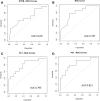Identification of potential biomarkers for predicting the early onset of diabetic cardiomyopathy in a mouse model
- PMID: 32703998
- PMCID: PMC7378836
- DOI: 10.1038/s41598-020-69254-x
Identification of potential biomarkers for predicting the early onset of diabetic cardiomyopathy in a mouse model
Abstract
Type 2 diabetes (T2D) is characterized by metabolic derangements that cause a shift in substrate preference, inducing cardiac interstitial fibrosis. Interstitial fibrosis plays a key role in aggravating left ventricular diastolic dysfunction (LVDD), which has previously been associated with the asymptomatic onset of heart failure. The latter is responsible for 80% of deaths among diabetic patients and has been termed diabetic cardiomyopathy (DCM). Through in silico prediction and subsequent detection in a leptin receptor-deficient db/db mice model (db/db), we confirmed the presence of previously identified potential biomarkers to detect the early onset of DCM. Differential expression of Lysyl Oxidase Like 2 (LOXL2) and Electron Transfer Flavoprotein Beta Subunit (ETFβ), in both serum and heart tissue of 6-16-week-old db/db mice, correlated with a reduced left-ventricular diastolic dysfunction as assessed by high-resolution Doppler echocardiography. Principal component analysis of the combined biomarkers, LOXL2 and ETFβ, further displayed a significant difference between wild type and db/db mice from as early as 9 weeks of age. Knockdown in H9c2 cells, utilising siRNA of either LOXL2 or ETFβ, revealed a decrease in the expression of Collagen Type I Alpha1 (COL1A1), a marker known to contribute to enhanced myocardial fibrosis. Additionally, receiver-operating curve (ROC) analysis of the proposed diagnostic profile showed that the combination of LOXL2 and ETFβ resulted in an area under the curve (AUC) of 0.813, with a cut-off point of 0.824, thus suggesting the favorable positive predictive power of the model and further supporting the use of LOXL2 and ETFβ as possible early predictive DCM biomarkers.
Conflict of interest statement
The authors declare no competing interests.
Figures







References
-
- IDF. International Diabetes Federation (IDF) Diabetes Atlas (9th Edition) Global fact sheet. 1–2 (2019).
-
- WHO. World Health Organization. Hypertensive Fact Sheet (2019).
Publication types
MeSH terms
Substances
LinkOut - more resources
Full Text Sources
Medical
Molecular Biology Databases
Miscellaneous

